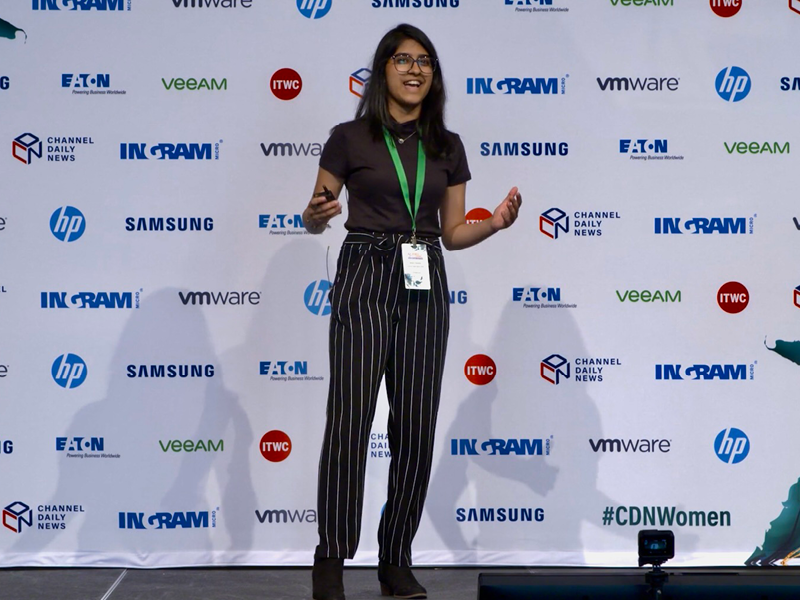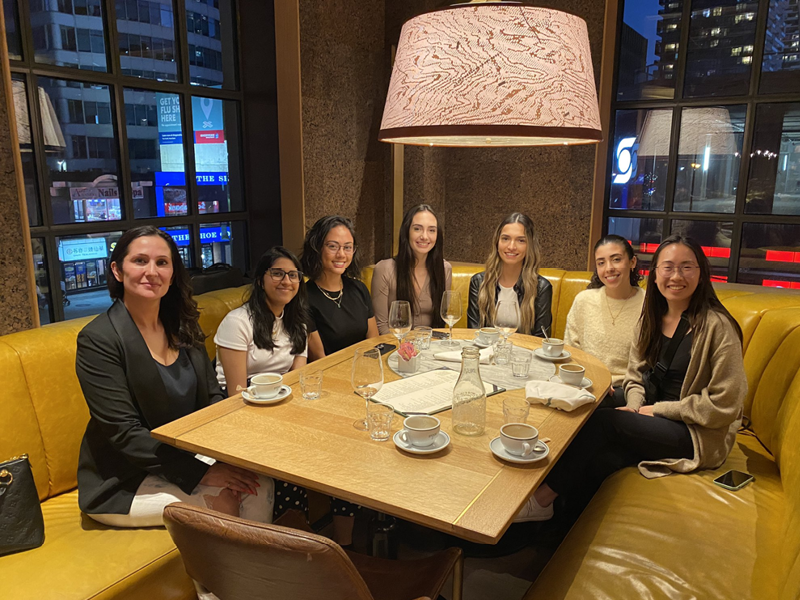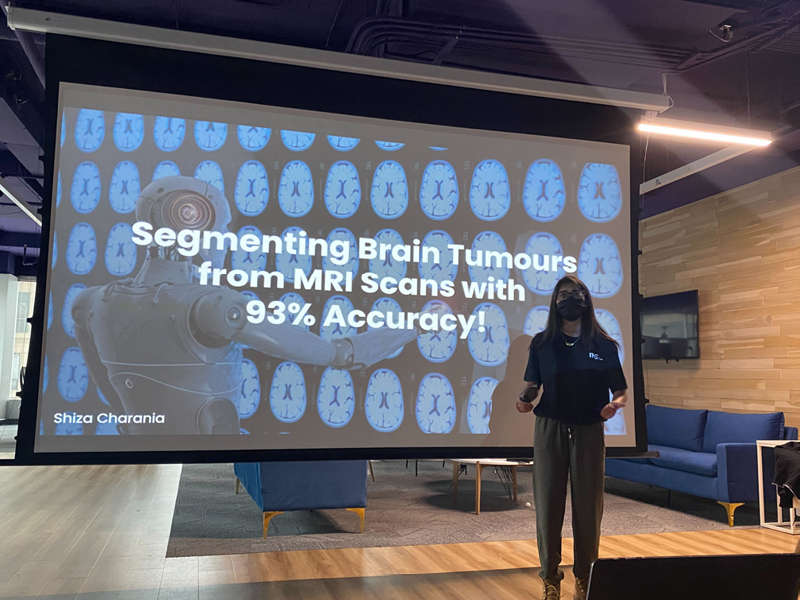How a young biomedical researcher is changing minds

Shiza Charania presenting her biomedical imaging research and discussing the merits of artificial intelligence (AI) in the healthcare space.
In early 2022, Dr. April Khademi, a biomedical engineering professor at Toronto Metropolitan University (TMU), received an intriguing email from a researcher named Shiza Charania. Shiza was looking to discuss her latest project: an algorithm that could segment brain tumours from two-dimensional (2D) magnetic resonance imaging (MRI) scans with a 93% accuracy rate. After several energized conversations together, Khademi was inspired to support Shiza’s work.
There was just one catch – Shiza was a fifteen-year-old highschooler.
Chance would soon arrive in the form of a grant, which allowed Khademi to bring on an intern for her Image Analysis in Medicine Lab (IAMLAB) – without the post-secondary eligibility requirements typically attached to research grants. For both women, the opportunity was a dream come true.
As a Biomedical Imaging Intern, Shiza would now spend her summer getting hands on with advanced biomedical imaging tools and data, working side-by-side with graduate researchers at one of TMU’s leading biomedical engineering labs. For Khademi, she could mentor, and learn from, a bright young mind while helping to open doors for another woman in the engineering field. She acknowledges that “the reason why we don't have enough women in STEM, isn't because we're not good at it. It's because we're not exposed to it when we're young.”
With Khademi’s mentorship, and IAMLAB’s resources, Shiza could now add a powerful third dimension to her 2D research. This was a true eye-opener for the young analyst. “I learned so much in terms of 3D data. How is 3D data structured? What types of novel architectures exist in papers? I got a real sense of what's out there in the space and what components actually help from a modeling perspective.”
Brain tumours are notoriously difficult to detect because they are heterogeneous masses with a high variability in appearance. Trying to separate a tumour’s components from different regions of the brain adds another barrier to identification. While 2D data can provide visibility into the general shape and location of a tumour, it lacks deeper insight. Fortunately, 3D data is allowing researchers like Shiza, and those at the IAMLAB, to identify and label each component of a brain tumour with incredible accuracy.
With the end of summer in 2022, came the return to high school for Shiza. Shifting to remote collaboration ever since, she and Khademi continue to refine the 3D segmentation model that began in the lab. Their momentum is fuelled by a shared passion for enhancing patient care. In between homework, Shiza actively feeds 3D data to the artificial intelligence (AI) model, looking to increase its accuracy and objectivity. The hope is – in the near future – this type of segmentation model can be used to guide highly-confident and accurate surgical resections, as well as better inform treatment plans for patients.
Reflecting back on the summer experience, the memories for both women go beyond their AI and computer vision work. With a smile, Shiza recounts, “The girls’ night out was really nice, hanging out for the night with a bunch of other women researchers from the lab.” For Khademi, or “Dr. K” as Shiza now affectionately calls her, the dinner out was a fun but meaningful sign of progress in the biomedical engineering field.
“When I was completing my PhD, I was one woman in a room of forty men. There were no women professors in my department, not a single one.”

Dr. April Khademi, with Shiza and other women researchers from the IAMLAB, having a social night out.
Championing Shiza, and other young women in the engineering field will always be a focus for Khademi. For other researchers in STEM fields, she hopes Shiza’s story will be a reminder to never underestimate the capabilities of youth. “I would have never imagined a fifteen year old talking to me about loss functions and AI deployment challenges,” she says. “I've been living this for many years, breathing this for many years. And she's got such a great understanding already.”
Now sixteen years old, Shiza continues to evolve her knowledge of AI. One of the many ways she does this is by keeping up with peer-reviewed papers about AI and computer vision. But in true Shiza fashion, she takes this one step further by breaking down this complex subject matter in her YouTube series, Reading Research Papers at 1am – turning head-scratching terminology into head-nodding concepts. With a natural knack for making the topic of AI more accessible, Shiza is helping to stir up interest and collaboration in the field.
During a recent keynote talk at the 2022 Women in IT Channel Recognition Luncheon, Shiza exclaimed, “To be honest, I was quite iffy about letting a robot work with patients, especially if it’s going to take over the world one day.” Laughs broke out across the crowd. Shiza then went on to educate her captivated audience about the merits of AI in the healthcare space.

Shiza presenting her biomedical research at The Knowledge Society.
One may glance at Shiza’s expansive resume of achievements – multiple biomedical imaging internships, an active member of The Knowledge Society, frequent industry presentations, and an AI collaboration with Walmart – and assume these are the opportunities that are naturally gifted to such a technical wunderkind. But the truth is, Shiza has had to forge her own pathways into the engineering field. Her approach? Good-old fashioned outreach. “I try to put myself out there, sending emails to anyone that might be open to a talk. Leveraging social media is also a great way to meet cool people in the space.”
Based on her work with Khademi, as well as an ongoing biomedical imaging development project with the University Health Network, Shiza acknowledges that “AI is really hard to contribute to on an individual level. You really need access to computing power and resources.” While she hopes to eventually work with one of the big players in the AI industry, such as OpenAI or DeepMind, which both possess ample resources, Shiza’s not waiting for the future to come to her.
At the end of the day, she says, “I just try to find ways to build serendipity.”
—
To learn more about Shiza Charania’s work, follow the channels below:
- AI Substack (external link)
- LinkedIn (external link)
- Twitter (external link)
- Website (external link)
- YouTube channel (external link)
To learn more about Dr. April Khademi’s work, view the channels below: